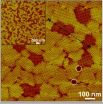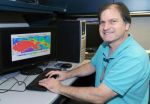(Press-News.org) Proteins are able to self-assemble into a wide range of highly ordered structures that feature a diverse array of properties. Through biomimicry - technological innovation inspired by nature – humans hope to emulate proteins and produce our own version of self-assembling molecules. A key to accomplishing this is understanding how protein-folding – a process critical to the form and function of a protein – is extended from individual proteins to complex assemblies.
Researchers with the U.S. Department of Energy (DOE)'s Lawrence Berkeley National Laboratory (Berkeley Lab) have now shown that a concept widely accepted as describing the folding of a single individual protein is also applicable to the self-assembly of multiple proteins. Their findings provide important guidelines for future biomimicry efforts, particularly for device fabrication and nanoscale synthesis.
"We've made the first direct observations that the concept of a folding funnel with kinetic energy traps for individual proteins can be equally applied to the assembly of ordered protein structures," says Jim DeYoreo, a scientist with the Molecular Foundry, a DOE nanoscience center at Berkeley Lab, who led this research along with Berkeley Lab chemist Carolyn Bertozzi. "Our results tell us that efforts to discover and codify the design rules for the self-assembly of complex molecular systems will have to take into account the impact of kinetic traps associated with conformational transformations."
DeYoreo and Bertozzi are the corresponding authors of a paper published by the Proceedings of the National Academy of Sciences (PNAS) that reported this research. The paper is titled "Direct observation of kinetic traps associated with structural transformations leading to multiple pathways of S-layer assembly." Co-authoring the paper were Seong-Ho Shin, Sungwook Chung, Babak Sanii and Luis Comolli.
Proteins are essentially biomolecular nanomachines capable of performing numerous tasks because of their ability to fold themselves into a multitude of shapes and forms. When individual proteins self-assemble into ordered structures the resulting ensemble often adopts conformations that are quite distinct from those of the individual components.
"For example, collagen matrices, which constitute the organic scaffolds of bones and teeth, are constructed from triple helices of individual collagen monomers," DeYoreo says. "These helices will further assemble into highly organized twisted fibrils that exhibit a pseudohexagonal symmetry."
The folding funnel concept explains individual protein folding on the basis of conformational changes to reach a state of minimal free energy. An unfolded protein starts out in a state of high free energy that makes its conformation unstable. Initially, there are a number of possible three-dimensional conformations that would reduce this free energy. However, as the protein starts to fold, the free energy begins to drop and the number of possible conformations begins to decrease like the shrinking width of a funnel. The bottom of the funnel is reached when free energy is minimized and there is only one available conformation. As the free energy drops, however, there may be kinetic traps along the way that can stop the folding process and hold the protein in partially folded conformations, known as molten globules and folding intermediates, for extended periods of time. Eventually these trapped conformational states will be transformed into a stable conformation but the shape and form of that final conformation is influenced by the kinetic traps.
"In a protein folding funnel, the funnel walls are presumed not to be smooth and the resulting bumps and valleys define kinetic traps," DeYoreo says. "This physical picture of folding has been explored in some detail at the single molecule level, but has not been considered for protein self-assembly into extended architectures even though conformational transformations are part and parcel of the self-assembly process."
DeYoreo, Bertozzi and their colleagues took steps to correct this knowledge deficit by studying the surface-layer (S-layer) proteins that self-assemble into a crystalline membrane around the single cells of bacteria and Archaea. This outer membrane
serves as the first point of contact between the microbe and its environment and is key to the microbe's ability to survive. Using in situ Atomic Force Microscopy (AFM), the researchers imaged in real time and at the molecular level kinetic trapping during the 2D self-assembly of S-layer protein structures on mica surfaces.
"We observed that self-assembly of S-layer proteins tracks along two different pathways, one leading directly to the low-energy final, ordered state, and the other leading to a kinetic trap occupied by a long-lived transient state that is more disordered," DeYoreo says. "Although either state is easily accessible during crystal nucleation, if the system falls into the high-energy state, escape to the final, low-energy state is strongly impeded at room temperature. This demonstrates the importance of kinetic traps in determining the pathway of S-layer crystallization and suggests that the concept of folding funnels is equally valid for self-assembly of extended protein structures."
INFORMATION:
This research was supported by the DOE Office of Science.
Lawrence Berkeley National Laboratory addresses the world's most urgent scientific challenges by advancing sustainable energy, protecting human health, creating new materials, and revealing the origin and fate of the universe. Founded in 1931, Berkeley Lab's scientific expertise has been recognized with 13 Nobel prizes. The University of California manages Berkeley Lab for the U.S. Department of Energy's Office of Science. For more, visit www.lbl.gov.
The Molecular Foundry is one of five DOE Nanoscale Science Research Centers (NSRCs), national user facilities for interdisciplinary research at the nanoscale, supported by the DOE Office of Science. Together the NSRCs comprise a suite of complementary facilities that provide researchers with state-of-the-art capabilities to fabricate, process, characterize, and model nanoscale materials, and constitute the largest infrastructure investment of the National Nanotechnology Initiative. The NSRCs are located at DOE's Argonne, Brookhaven, Lawrence Berkeley, Oak Ridge and Sandia and Los Alamos national laboratories. For more information about the DOE NSRCs, please visit http://science.energy.gov/bes/suf/user-facilities/nanoscale-science-research-centers/.
DOE's Office of Science is the single largest supporter of basic research in the physical sciences in the United States, and is working to address some of the most pressing challenges of our time. For more information, please visit the Office of Science website at science.energy.gov/.
Folding funnels key to biomimicry
Berkeley Lab finding that protein folding funnels also apply to self-assembly should benefit biomimicry and nanosynthesis
2012-11-01
ELSE PRESS RELEASES FROM THIS DATE:
Satellite captures the life and death of Hurricane Sandy on Halloween
2012-11-01
VIDEO:
This animation of satellite imagery shows the life of Hurricane Sandy from its development in the Caribbean Sea on Oct. 21, through its track up the US East coast and...
Click here for more information.
Hurricane Sandy is giving up the ghost on Halloween over Penn. As the storm weakened to a remnant low pressure area the NASA GOES Project released an animation of NOAA's GOES-13 satellite imagery covering Hurricane Sandy's entire life.
The GOES-13 satellite is managed ...
NASA/NOAA's Suomi NPP captures night-time view of Sandy's landfall
2012-11-01
As Hurricane Sandy made a historic landfall on the New Jersey coast during the night of Oct. 29, the Visible Infrared Imaging Radiometer Suite (VIIRS) on NASA/NOAA's Suomi National Polar-orbiting Partnership (NPP) satellite captured this night-time view of the storm. This image provided by University of Wisconsin-Madison is a composite of several satellite passes over North America taken 16 to18 hours before Sandy's landfall.
The storm was captured by a special "day-night band," which detects light in a range of wavelengths from green to near-infrared and uses filtering ...
Dust's warming counters half of its cooling effect
2012-11-01
The mineral properties of the aerosol particles and the wavelength distribution of incident light combine to determine whether a dust particle reflects radiation and cools the local atmosphere, absorbs radiation and warms the local atmosphere, or both. While scientists have a good handle on dust's primary effect of reflecting and cooling at the visible wavelengths, the smaller influence of absorbing and warming at the longer infrared wavelengths has remained more of an uncertainty – and most climate models either underestimate it or do not include it at all.
When the ...
More evidence needed to support use of autism interventions
2012-11-01
Interventions designed to improve core deficits in children with autism spectrum disorders are supported by varying levels of evidence, highlighting the need for well-designed studies to better evaluate the interventions, according to a new RAND Corporation study.
Researchers found that when they evaluated the past research on a wide variety of interventions aimed at improving core deficits in social/communication, language, behavior and adaptive skills, the evidence of efficacy ranged from moderate to insufficient. The findings are published in the November edition of ...
The cost of prescription drugs -- a comparison of 2 countries
2012-11-01
(Boston) - In the United States, the cost paid for statins (drugs to lower cholesterol) in people under the age of 65 who have private insurance continues to exceed comparable costs paid by the government in the United Kingdom (U.K.) by more than three fold. These results from Boston University's Boston Collaborative Drug Surveillance Program, are a follow up of an ongoing comparison of prescription drug costs between the U.S. and U.K. The initial results reported on relative drug costs in 2005. The current updated results for 2009 appear this week in the journal Pharmacotherapy. ...
Study: Repeated surgeries appear to extend life of patients with deadliest of brain cancers
2012-11-01
People who undergo repeated surgeries to remove glioblastomas — the most aggressive and deadliest type of brain tumors — may survive longer than those who have just a one-time operation, new Johns Hopkins research suggests.
Glioblastoma, the brain cancer that killed Sen. Edward Kennedy, inevitably returns after tumor-removal surgery, chemotherapy, and/or radiation. The median survival time after diagnosis is only 14 months. With recurrence a near certainty, experts say, many have questioned the value of performing second, third or even fourth operations, especially given ...
Study: Use of antipsychotic drugs improves life expectancy for individuals with schizophrenia
2012-11-01
Results of a Johns Hopkins study suggest that individuals with schizophrenia are significantly more likely to live longer if they take their antipsychotic drugs on schedule, avoid extremely high doses and also regularly see a mental health professional.
Psychiatrists have long known that people with schizophrenia who stick to a drug regimen have fewer of the debilitating delusions and hallucinations that are hallmarks of this illness. But there have been concerns about whether some of the known side effects of the medications — increased risk of cardiovascular disease ...
Understanding Workplace Sexual Harassment
2012-11-01
Understanding Workplace Sexual Harassment
No one should ever be subjected to a situation where they feel unsafe at work. Sexual harassment can have huge negative effects not only on individual workers, but on the workplace as a whole.
Understanding what sexual harassment is can go a long way toward making a workplace safer. Many employees don't take action to stop sexual harassment because they aren't fully aware of their rights. In other cases, a supervisor or coworker perpetrating the harassment may not even be aware that their conduct is both harmful and illegal.
What ...
EEOC: Workplace Discrimination Claims Hit Record High in 2011
2012-11-01
EEOC: Workplace Discrimination Claims Hit Record High in 2011
The American workforce is getting more diverse, and that's a good thing. However, some employers have been slower than others to adapt to these changing demographics.
Nowhere is this more evident than in the fact that the U.S. Equal Employment Opportunity Commission reported a record-high number of workplace discrimination complaints last year. All told, the EEOC received almost 100,000 complaints in 2011.
The largest increase came from religious discrimination complaints, which were up 9.5 percent from ...
New Law Reduces Penalties for Marijuana Possession in Maryland
2012-11-01
New Law Reduces Penalties for Marijuana Possession in Maryland
Maryland's drug laws are some of the toughest on the east coast. Currently, a person convicted of possessing less than 10 grams of marijuana can face up to a year in jail and a $1000 fine. In comparison, in nearby states the penalty for possessing similar amounts of marijuana is limited to 30 days in jail and a maximum $500 fine.
A recently passed bill aims to relax the strict penalties for Maryland residents convicted of possessing only a small amount of marijuana. Supporters of the bill say it will help ...
LAST 30 PRESS RELEASES:
The Ceramic Society of Japan’s Oxoate Ceramics Research Association launches new international book project
Heart-brain connection: international study reveals the role of the vagus nerve in keeping the heart young
Researchers identify Rb1 as a predictive biomarker for a new therapeutic strategy in some breast cancers
Survey reveals ethical gaps slowing AI adoption in pediatric surgery
Stimulant ADHD medications work differently than thought
AI overestimates how smart people are, according to HSE economists
HSE researchers create genome-wide map of quadruplexes
Scientists boost cell "powerhouses" to burn more calories
Automatic label checking: The missing step in making reliable medical AI
Low daily alcohol intake linked to 50% heightened mouth cancer risk in India
American Meteorological Society announces Rick Spinrad as 2026 President-Elect
Biomass-based carbon capture spotlighted in newly released global climate webinar recording
Illuminating invisible nano pollutants: advanced bioimaging tracks the full journey of emerging nanoscale contaminants in living systems
How does age affect recovery from spinal cord injury?
Novel AI tool offers prognosis for patients with head and neck cancer
Fathers’ microplastic exposure tied to their children’s metabolic problems
Research validates laboratory model for studying high-grade serous ovarian cancer
SIR 2026 delivers transformative breakthroughs in minimally invasive medicine to improve patient care
Stem Cell Reports most downloaded papers of 2025 highlight the breadth and impact of stem cell research
Oxford-led study estimates NHS spends around 3% of its primary and secondary care budget on the health impacts of heat and cold in England
A researcher’s long quest leads to a smart composite breakthrough
Urban wild bees act as “microbial sensors” of city health.
New study finds where you live affects recovery after a hip fracture
Forecasting the impact of fully automated vehicle adoption on US road traffic injuries
Alcohol-related hospitalizations from 2016 to 2022
Semaglutide and hospitalizations in patients with obesity and established cardiovascular disease
Researchers ‘listen in’ to embryo-mother interactions during implantation using a culture system replicating the womb lining
How changing your diet could help save the world
How to make AI truly scalable and reliable for real-time traffic assignment?
Beyond fragmented markets: A new framework for efficient and stable ride-pooling
[Press-News.org] Folding funnels key to biomimicryBerkeley Lab finding that protein folding funnels also apply to self-assembly should benefit biomimicry and nanosynthesis



